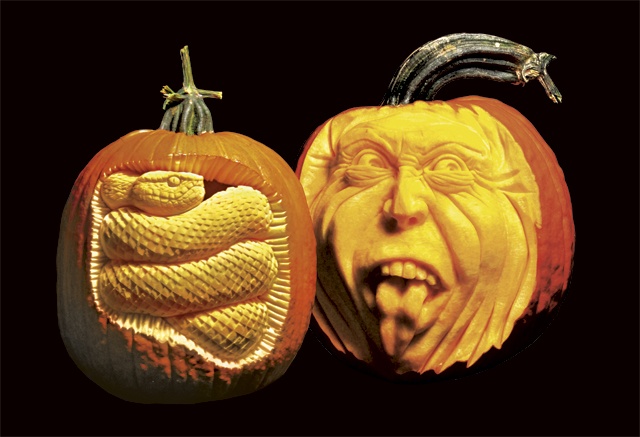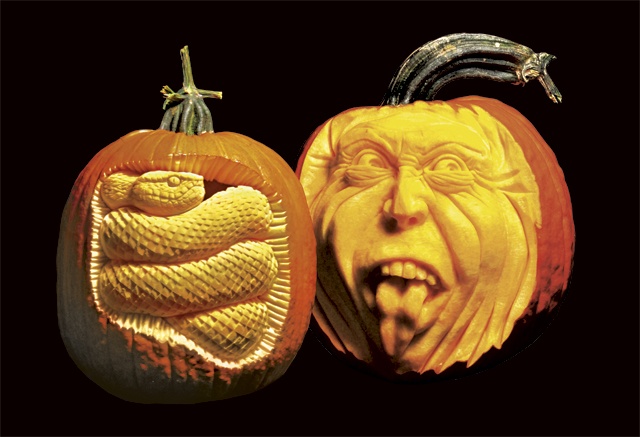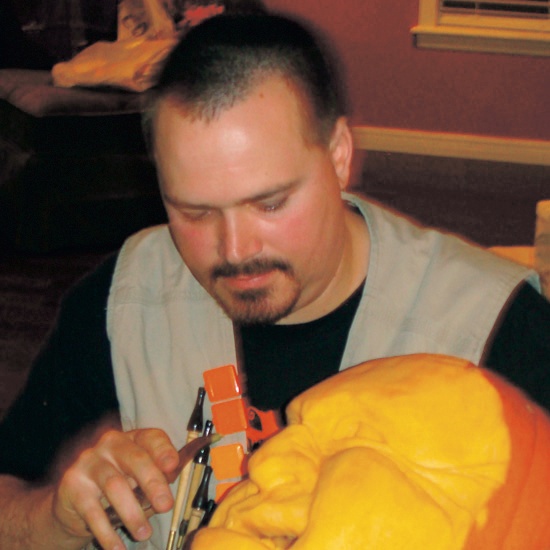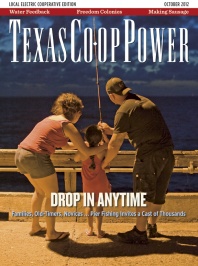In his classroom at Perryton Junior High School, art teacher Scott Cummins keeps a stash of pumpkins of all shapes and sizes under a corner table. “I had to throw a pumpkin out yesterday,” he said in early April. “I like to see how long they’ll last. Out of these, I may have one or two make it to May. I just never know when I might need one.”
Inspiration’s that way. Unpredictable. So when his last pumpkin turns mushy, Cummins must wait until October to resume his favorite hobby: pumpkin carving. Forget jack-o’-lanterns with toothy grins and triangular eyes. Instead, Cummins, 40, uses assorted tools to sculpt three-dimensional works of art that range from creepy to silly. Since his start in the mid-1990s, the self-proclaimed “Pumpkingutter” has transformed hundreds of pumpkins into grotesque zombies, bug-eyed aliens, cartoon characters, famous folks (living and not) and critters of all kinds.
Many reflect his quirky sense of humor, like four banded front teeth in a grinning mouth that’s simply titled “Braces.”
As a boy growing up in Hollis, Oklahoma, Cummins kept a sketchpad handy, drawing whatever caught his eye—dogs, bugs, deer, pickups, tractors. “I attempted to draw comic strips a lot, too,” he recalled. “At my high school, we didn’t have art classes, so in college I took different art courses, which were mostly commercial art- and illustration-related.”
In 1995, he graduated from Southwestern Oklahoma State University with a degree in commercial art and then landed his first (and current) teaching job in Perryton, which is served by North Plains Electric Cooperative. One day, on a whim, he picked up a pumpkin and started carving. “As a kid, I’d carved pumpkins and skinned off rind to make different colors,” Cummins says. “So I decided I’d experiment. On my first try, I carved an alien. On my second pumpkin, I carved a skull. I kept practicing, and I’d photograph some of my work.”
Hoping to generate interest in his more conventional artwork, Cummins posted the pictures on his freelance art website, Outside the Lines. The idea worked. Sort of. “I got more feedback and traffic on my pumpkin pages than my other pages,” he said. “I didn’t get any more business, but the pumpkin pictures got shared and passed around the Internet. So I kept carving pumpkins. I put up more pictures the next year and the next.”
Fans went nuts over his scar-faced “Pumpkenstein.” An owl head with glaring eyes. A gigantic eye with eyelashes. “Tex,” a mustached cowboy minus his hat. Elvis crooning into a mic (aka “You Were Always on My Rind”). A toothy dinosaur named “Pumpkinasaurus Rex.” A pug-nosed bulldog with a lolling tongue.
“Finally, I decided my pumpkins needed their own website, so I came up with the name of Pumpkingutter,” Cummins said. In addition to annual photo galleries, Cummins posted a carving tutorial with tips and videos on how to gut a pumpkin. He explains how to sculpt basic shapes, polish the rind with a scouring pad and add fine details, like wrinkles, fur or hair. He also covers how to preserve a pumpkin. (“You really can’t,” Cummins says. “Take good photos instead.”) On other pages, visitors can read his list of frequently asked questions (“Are those real pumpkins?”) and watch a time-lapse video of him carving “Liberty Pumpkin,” the Statue of Liberty’s crown-topped head.
As soon as pumpkin patches open in October, Cummins browses vines in the field and hand-cuts a pickup load. He usually gets them near Sunray, about 70 miles southwest of Perryton. “I leave a long stem intact,” he said. “I’ve been told that stems provide nutrients to pumpkins so they stay fresher longer. I always choose the heaviest pumpkins because extra weight is usually in the rind.”
Typically, his one- to two-hour carving sessions happen in his classroom after school’s out for the day. Using ribbon tools, sharpened scoops and slim blades, Cummins carves away flesh and rind as his subject takes form.
“I spread a plastic sheet across the floor for faster cleanup because the process is messy,” he said. “Sometimes I have an idea before I start. Or I’ll pick up a pumpkin, then think of an idea. I’d rather carve faces than anything else, probably because of the tradition of faces on pumpkins.”
Thanks to his popularity via the Internet, Cummins has been invited to demonstrate his unique talent at fairs, schools and private events. He’s even been featured in the book, 2008 Ripley’s Believe It or Not! (Random House, Inc.).
Through the years, many admirers have suggested ways to preserve his pumpkin masterpieces. “One of my first comments on my website said it was a shame that they don’t last,” Cummins said. “People are so used to art being permanent. But that’s what appeals to me—pumpkin carving is temporary. It’s novel. I’ve always liked that kind of art, like sand sculptures and sidewalk drawings. They take a lot of work and effort, just like pumpkin carving. For me, it’s the act of doing it. Once a pumpkin’s gone, then I can do another one.”
“Someone once suggested I make a casting of a pumpkin that I’d carved into a face,” he added. “But there’s nothing unusual about a face by itself. What’s interesting is that it’s carved on a pumpkin. That’s the whole point—it’s a pumpkin.”
——————-
Sheryl Smith-Rodgers, frequent contributor




